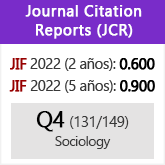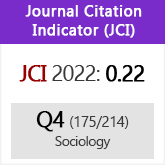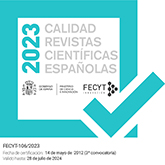El vínculo entre conductas prosociales (de donación) y la cohesión social
DOI:
https://doi.org/10.3989/ris.2018.76.1.15.125Palabras clave:
caridad, cohesión social, dotación, donar, experimento, prosocialResumen
Mediante un experimento controlado se establece que las diferencias en proximidad relacional puede evocar o suprimir una disposición a dar a una causa sin relación. Cuatro grupos de tratamiento se sometieron al mismo conjunto de ejercicios, pero dos en un ambiente relacional más cercano y dos en un entorno relacional más distante. La mitad de los sujetos en cada ambiente relacional recibió un doble pago sin previo aviso. De salida, todos los participantes tuvieron la opción de dar a la caridad. El experimento mostró que la donación caritativa estuvo guiada por factores relacionales y no por el pago. Podemos aprender que las inclinaciones pro-sociales (pro-donación) interactúan con el ambiente social más amplio, y que estos complejos parámetros relacionales pudieran ser evaluados por patrones de donaciones fáciles de medir.
Descargas
Citas
Adhikari, K. and P. Goldey. 2010. "Social Capital and its 'Downside'." World Development 38(2): 184-194. https://doi.org/10.1016/j.worlddev.2009.10.012
Aguiar, F., P. Bra-as-Garza and L. Miller. 2008. "Moral Distance in Dictator Games." Judgment and Decision Making 3(4): 244-354. http://journal.sjdm.org/jdm71218.pdf
Ariely, D. 2008. Predictably irrational. New York: HarperCollins.
Attanasi, G., F. Casoria, S. Centorrino and G. Urso. 2013. "Cultural investment, local development and instantaneous social capital." Journal of Socio-Economics 47: 228-247. https://doi.org/10.1016/j.socec.2013.05.014
Auten, G. and G. Rudney. 1990. "The Variability of Individual Charitable Giving in the US." Voluntas 1(2): 80-97. https://doi.org/10.1007/BF01397439
Bardsley, N. 2000. "Theoretical and empirical investigation of nonselfish behaviour: the case of contributions to public goods." PhD thesis. University of East Anglia.
Baron, D. 2010. "Morally Motivated Self-Regulation." American Economic Review 100(4): 1299-1329. https://doi.org/10.1257/aer.100.4.1299
Bartolini, S., E. Bilancini and M. Pugno. 2013. "Did the Decline in Social Connections Depress Americans' Happiness?." Social Indicators Research 110(3): 1033- 1059. https://doi.org/10.1007/s11205-011-9971-x
Bauer, T., J. Bredtmann and C. Schmidt. 2012. "Time vs. Money: the supply of voluntary labor and charitable donations across Europe." RUHR Economic Papers no. 349. http:// econstor.eu/bitstream/10419/61455/1/722252412.pdf
Berger, P. and T. Luckmann. 1966. The social construction of reality. Garden City, N.Y.: Doubleday.
Boyd, E. 2014. "Exploring principles of adaptive governance for managing tipping points." Pp. 258-276 in Addressing tipping points for a precarious future, edited by T. O'Riordan and T. Lenton. British Academy Scholarship Online.
Breeze, B. 2006. "Robin Hood in Reverse: exploring the relationship between income and charitable giving." Voluntary Sector Working Paper, 3. http://eprints.lse. ac.uk/29223/
Center on Philanthropy at Indiana University in the USA. 2007. "Patterns of household charitable giving by income group, 2005." https://philanthropy.iupui.edu/files/research/giving_ focused_on_meeting_needs_of_the_poor_july_2007.pdf
Chowdhury, S. and J. Jeon. 2014. "Impure altruism or inequality aversion?" Journal of Public Economics. 118:143-150. https://doi.org/10.1016/j.jpubeco.2014.07.003
Crawford, J. R. and J. D. Henry. 2004. The positive and negative affect schedule (PANAS): Construct validity, measurement properties and normative data in a large non-clinical sample. British Journal of Clinical Psychology, 43:245-265. https://doi.org/10.1348/0144665031752934 PMid:15333231
Dasgupta, P. 2009. "A matter of trust". Annual Bank Conference on Development Economics (ABCDE). Seoul. http:// www.kdi.re.kr/upload/12623/a2-1.pdf
DeScioli, P. and S. Krishna. 2013. "Giving to whom? Altruism in different types of relationships." Journal of Economic Psychology 34:218-228. https://doi.org/10.1016/j.joep.2012.10.003
Dessi, R. and B. Monin. 2012. "Noblesse Oblige? Moral identity and prosocial behavior in the face of selfishness." TSE working paper 12-347. http://www.tse-fr.eu/sites/ default/files/medias/doc/wp/bee/wp_tse_347.pdf
Du Toit, A. 2004. "'Social exclusion' discourse and chronic poverty: A South African case study." Development and Change 35:987-1010. https://doi.org/10.1111/j.1467-7660.2004.00389.x
Durlauf, S. and M. Fafchamps. 2004. "Social Capital". Wisconsin Madison Social Systems Working paper 12. https:// econpapers.repec.org/paper/attwimass/200412.htm
Fehr, E. and K. Schmidt. 1999. "A theory of fairness, competition, and cooperation." Quarterly Journal of Economics 114:817-868. https://doi.org/10.1162/003355399556151
Giddens, A. 1984. The constitution of society: outline of the theory of structuration. Cambridge: Polity.
Grootaert, C. and T. Van Bastelaer. 2002. The role of social capital in development. Cambridge: Cambridge University Press. https://doi.org/10.1017/CBO9780511492600
Gui, B. and R. Sugden. 2010. Economics and social interaction: accounting for interpersonal relations. Cambridge: Cambridge University Press.
Guiso, L., P. Sapienza and L. Zingales. 2010. "Civic capital as the missing link." NBER working paper nº 15845. http:// www.nber.org/papers/w15845
Hess, J., A. Fannin and L. Pollom. 2007. "Creating closeness: Discerning and measuring strategies for fostering closer relationships." Personal Relationships 14:25-44. https://doi.org/10.1111/j.1475-6811.2006.00140.x
Hoffman, E., K. McCabe and V. Smith. 1996. "Social distance and other-regarding behavior in dictator games." American Economic Review 86:653-660. http://www.jstor.org/stable/2118218
Holland, J., A. Silva and R. Mace. 2012. "Lost letter measure of variation in altruistic behaviour in 20 neighbourhoods." PLoS ONE 7:e43294. https://doi.org/10.1371/journal.pone.0043294 PMid:22905250 PMCid:PMC3419711
Holloway, S., L. Tucker and H. Hornstein. 1977. "The effects of Social and Non-Social Information on Interpersonal-Behavior of Males." Journal of Personality and Social Psychology 35:514-522. https://doi.org/10.1037/0022-3514.35.7.514
Hornstein, H., E. Lakind, G. Frankel and S. Manne. 1975. "Effects of Knowledge About Remote Social Events on Prosocial Behavior, Social Conception, and Mood." Journal of Personality and Social Psychology 32:1038- 1046. https://doi.org/10.1037/0022-3514.32.6.1038
Kolm, S-C. and J. Ythier. 2006. Handbook on the economics of giving, reciprocity and altruism. Amsterdam; London: Elsevier.
Konow, J. 2010. "Mixed feelings: Theories of and evidence on giving." Journal of Public Economics 94:279-297. https://doi.org/10.1016/j.jpubeco.2009.11.008
Kosse, F., T. Deckers, H. Schildberg-Hörisch and A. Falk. 2016. "The Formation of Prosociality: Causal Evidence on the Role of Social Environment." IZA DP No. 9861. http://ftp.iza.org/dp9861.pdf
Krishna, A. and N. Uphoff. 2002. "Mapping and measuring social captial." Pp. 85-124 in The role of social capital in development, edited by C. Grootaert and Van Bastelaer, T. Cambridge: Cambridge University Press. https://doi.org/10.1017/CBO9780511492600.005 PMid:11913974
Lindsey, R. 2012. "Exploring Local Hotspots and Deserts." CGAP Working Paper. http://www.cgap.org.uk/ uploads/Working%20Papers/CGAP%20WP%20 hotspots%20and%20deserts%20RLindsey.pdf
Mayo, J. and C. Tinsley. 2009. "Warm glow and charitable giving: Why the wealthy do not give more to charity." Journal of Economic Psychology 30:490-499. https://doi.org/10.1016/j.joep.2008.06.001
Quibria, M. 2003. "The puzzle of social capital: a critical review." Asian Development Review 20:19-39.
Ross, L. and A. Ward. 1996. "Naive realism in everyday life." Pp. 103-135 in Values and knowledge, edited by Reed, E., Turiel, E. and Brown, T. Mahwah, N.J.: Erlbaum.
Schluter, M. and D. Lee. 2009. The relational manager. Oxford: Lion.
Schneider, F. and R. Weber. 2013. "Long-Term Commitment and Cooperation." Working Paper 130. University of Zürich. http://web.stanford.edu/group/SITE/ SITE_2013/2013_segment_7 2013_segment_7_papers/schneider.pdf
Sen, A. 2009. The idea of justice. London: Allen Lane.
Sobel, J. 2002. "Can we trust social capital?" Journal of Economic Literature 40:139-154. https://doi.org/10.1257/jel.40.1.139
Tillema, T., M. Dijst and T. Schwanen. 2010. "Face-to-face and electronic communications in maintaining social networks." New Media & Society 12:965-983. https://doi.org/10.1177/1461444809353011
Vajja, A. and H. White. 2008. "Can the World Bank build social capital?" Journal of Development Studies 44:1145- 1168. https://doi.org/10.1080/00220380802242404
Watson, D., L. Clark and A. Tellegen. 1988. "Development and Validation of Brief Measures of Positive and Negative Affect: the PANAS Scales." Journal of Personality and Social Psychology 54:1063-1070. https://doi.org/10.1037/0022-3514.54.6.1063 PMid:3397865
Wilkinson, R. and K. Pickett. 2009. The spirit level. London; New York: Allen Lane.
Zischka, L. 2016. "The interaction between prosocial (giving) behaviours and social cohesion." Discussion Paper No. 2016-124, University of Reading. http://www.reading.ac.uk/web/FILES/economics/emdp2016124.pdf
Publicado
Cómo citar
Número
Sección
Licencia
Derechos de autor 2018 Consejo Superior de Investigaciones Científicas (CSIC)

Esta obra está bajo una licencia internacional Creative Commons Atribución 4.0.
© CSIC. Los originales publicados en las ediciones impresa y electrónica de esta Revista son propiedad del Consejo Superior de Investigaciones Científicas, siendo necesario citar la procedencia en cualquier reproducción parcial o total.Salvo indicación contraria, todos los contenidos de la edición electrónica se distribuyen bajo una licencia de uso y distribución “Creative Commons Reconocimiento 4.0 Internacional ” (CC BY 4.0). Puede consultar desde aquí la versión informativa y el texto legal de la licencia. Esta circunstancia ha de hacerse constar expresamente de esta forma cuando sea necesario.
No se autoriza el depósito en repositorios, páginas web personales o similares de cualquier otra versión distinta a la publicada por el editor.

















